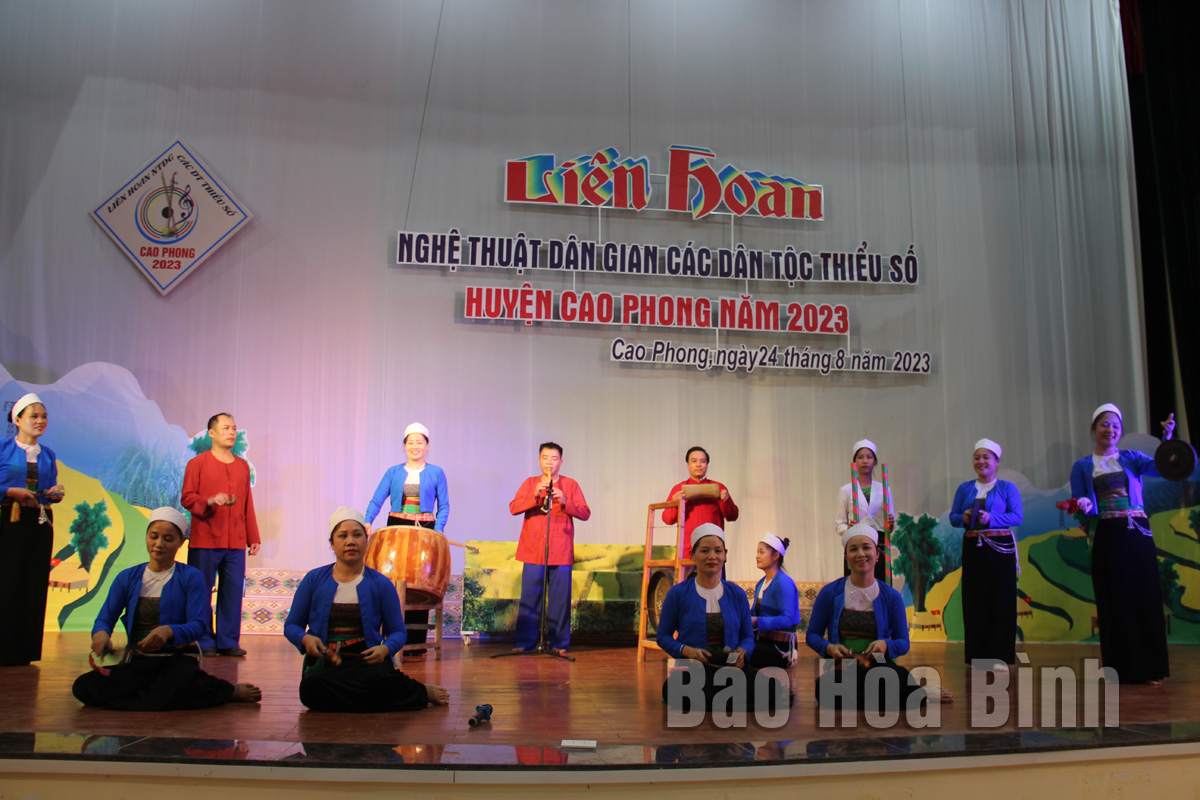
(HBO) - On August 24th, Cao Phong district organized the folk-art festival of the ethnic minorities in 2023.

The concert performance of
the ethnic musical instruments of Binh Thanh commune at the festival.
This year’s festival, there was the participation of more than 300
artisans and actors from 10 delegations all over the communes and towns in the
district. With the theme "Preserving and promoting the cultural identity of the
ethnic minorities in Cao Phong district”, each delegation brought an art
program themed throughout with genres: singing, dancing, and performing the
traditional musical instruments.
According to the evaluation of the jury, all of the units all had
unique and creative ideas with the elaborate and impressive performances,
imbued with the identity of the national cultures. The repertoire was rich and
diverse, especially the typical folk songs of the ethnic minorities in the
district. For example, the dancing performance "Praying for happiness” of Dung
Phong commune, "Muong Gong Concert” of Thach Yen commune; "Muong Thang Calling
Concert” of Tay Phong Commune; "Dong Vong Giang Mo” of Binh Thanh Commune...
At the end of the festival, the Organizing Committee awarded 9 A
prizes, 9 B prizes, 12 C prizes for the excellent performances; awarded 3 A
prizes, 3 B prizes, 4 C prizes for the whole delegation, of which 3 A prizes
were awarded to Dung Phong commune, Tay Phong commune and Cao Phong town.
The festival is a meaningful activity promoting the development of
the cultural and artistic movements, contributing to preserving and promoting
the traditional cultural values imbued with the identity of the ethnic
minorities in the district. This is also an opportunity for the people of the
district's ethnic groups to collect, preserve and promote the traditional and
unique folk art; This is an opportunity for the actors and the artists to
exchange and learn experiences in preserving and promoting the cultural values.
With an increasingly vibrant and widespread emulation movement aimed at building cultured residential areas and cultured families, Yen Thuy District has been making steady progress toward improving both the material and spiritual well-being of its people, while fostering a civilized, prosperous, beautiful, and progressive community.
Once lacking recreational spaces and community facilities, Residential Group 2 in Quynh Lam Ward (Hoa Binh City) has recently received attention for the construction of a new, spacious, and fully equipped cultural house. The project followed the model of state support combined with public contributions in both labor and funding.
The "All people unite to build cultural life" movement, which has been effectively integrated with Kim Boi district’s socio-economic development goals, is fostering a lively spirit of emulation across local residential areas, hamlets, villages, public agencies, and enterprises. In addition, through the initiative, traditional cultural values are being preserved and promoted, while community solidarity and mutual support in poverty reduction and economic development are being strengthened.
A working delegation of the Hoa Binh provincial People’s Committee led by its Permanent Vice Chairman Nguyen Van Toan on June 11 inspected the progress of a project to build the Mo Muong Cultural Heritage Conservation Space linked to tourism services in Hop Phong commune, Cao Phong district.
Born and growing in the heroic land of Muong Dong, Dinh Thi Kieu Dung, a resident in Bo town of Kim Boi district, in her childhood was nurtured by the sweet lullabies of her grandmother and mother. These melodies deeply imprinted on her soul, becoming an inseparable part of her love for her ethnic group's culture. For over 20 years, this love for her hometown has driven Dung to research, collect, and pass down the cultural values of the Muong people to future generations.
In the final days of May, the Ethnic Art Troupe of Hoa Binh Province organized performances to serve the people in remote, mountainous, and particularly disadvantaged areas within the province. These were not just ordinary artistic shows, but they were the meaningful journeys aimed at spreading cultural values, enhancing the spiritual life of the people and contributing to the preservation of ethnic minority cultural identities.



